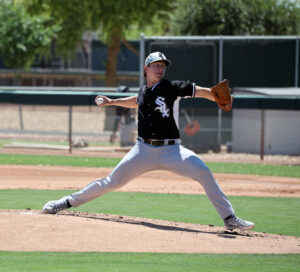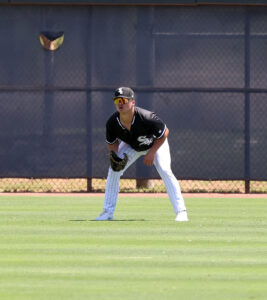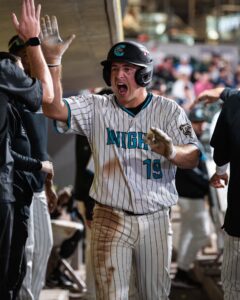Regaining Control of a Disappointing Season
In a season which was lost for a number of White Sox prospects due to injury or under-performance. Alec Hansen had one of the rougher years. Due to a forearm injury incurred during spring training, he did not make his first start until June 16 for Birmingham. Then he was beset by a round of wildness that he had not experienced since 2016 when he was at Oklahoma. In that season, his 7.0/9 BB rate caused him to be moved from the rotation to the bullpen. This resulted in his draft stock slipping from potential number one overall to 49th where the White Sox nabbed him in the second round.

Brief History Lesson
This move seemed to pay off for the White Sox as current Winston-Salem Dash pitching coach Matt Zaleski hooked up with Hansen at Great Falls. There some seemingly minor adjustments netted spectacular results.
“Yes, there are some small similarities [2018 vs 2016] where he was across his body too much and not getting back on time,” said Zaleski in an interview with FutureSox via phone as the first bands of hurricane Florence were hitting the area with some light rain. “His direction to home plate, sometimes he’s not getting through his front leg and leaving his head out, top half out at release causing him to leave the ball up and also pull fastballs when he does get out front. That’s what I saw when he came to Winston.”
Watching a game via the Milb app, my untrained eye was able to identify the 2018 version of the problems rather easily. In one at-bat, he was high-and-away to a left-hand hitter, then the next pitch was low-and-in almost hitting him. The pitches that were strikes were high in the zone. “That was the toughest thing to watch, you’d see him be good, you’d see him stay over the rubber and drive a pitch downhill in the zone and you be like, yep, there it is and then a couple batters later it got away from him. With his size that can happen,” Zaleski commented.

But in 2016, under the tutelage of Zaleski, he was able to eliminate those issues. Pitching for three teams in the organization that year, Hansen cut his walks per nine in half to 3.3 and backed it up with 3.2 the following season. It appeared that Hansen’s earlier struggles were behind him, but upon return from injury this season, his control problems returned. Across 14 starts in 2018, his BB rate per nine skyrocketed to 10.3.
Forearm Injury
On March 6, 2018, Hansen was scratched from a cactus league start with forearm soreness. At the time, White Sox general manager Rick Hahn told the Sun-Times.
‘‘Everything is fine with Alec,’’ general manager Rick Hahn said. ‘‘Anytime a guy expresses [soreness], we understandably — especially this time of year — err on side of caution and shut him down, get him looked at.’’
Hansen was expected to be at Birmingham at the start of the season, but the timeline was extended much further than originally indicated resulting in his first appearance taking place in mid-June. This caused some to speculate if the injury was more serious than the original assessment suggested. Forearm issues are tricky as they can be related to the UCL, which is the ligament associated with Tommy John surgery (not that anyone has heard that recently). Given this nightmare scenario, it makes sense that the organization was extra cautious with Hansen. Other than a July 13 start which he left after three innings and a mound visit from the trainer, the injury has not been mentioned.
The Struggle is Real
Hansen struggled at Birmingham from the onset, allowing nine hits in his season debut. His run with the Barons ended with a disastrous outing on July 29th in which he walked seven in an inning-and-a-third and connecting with the strike zone on only 28 of 60 pitches. He was subsequently reunited with Zaleski by moving down a level to Winston-Salem where his tendency to miss the strike zone persisted. He exited the season with an encouraging outing striking out seven and walking three while surrendering six hits in 3.2 innings pitched. He was able to hit the target on 51 of 88 pitches in that finale.
In addition to his wildness, he has also suffered a marked loss in velocity, causing some to start questioning his viability as a prospect. In an August 23rd article, 2080 Baseball offered up the following evaluation:
Really struggling this year, deep in his own head, slowing everything down to throw a strike. Too inconsistent to project as a starter, only chance at big league impact is in the ‘pen. Could pitch high-leverage innings if velocity returns and he takes to a relief role. Extreme risk, far from a sure thing, will lose prospect status if he doesn’t turn a corner soon.
There’s Video
For video evidence of how inconsistent Hansen’s delivery has become watch this video from 2080 Baseball from July 8, 2018, while he was at Birmingham. You’ll see examples of exactly what Zaleski was talking about. The crossfire motion is evident on a number of occasions, then you’ll see some solid follow through as well. The inconsistency is clear.
This video of him pitching from the stretch on 5-5-17 is interesting as it shows both the good and the bad in his delivery. On the first pitch, he falls back toward second base similar to the above video. One the second delivery, his follow through takes him towards home plate.
The stretch and the windup are not too terribly different, mechanically as far as he’s concerned. “I like the slide step, it gets him cleaned up and gets his direction towards home plate and due to his size, helps control the running game,” said Zaleski. “When his tempo is good out of the wind up he’s very good. It’s very repeatable.”
Getting Back on Track
“It’s tough working on things late in the season,” Zaleski added. “You go through an offseason workout program, then you get hurt in spring training, then you have to revamp everything and do a whole other throwing program. So it’s not just maintaining what you’ve done in the offseason, it’s having to redo a whole throwing program.”
“We were limiting his innings to try to get him out on a positive note. If it went well, we’d send him out for another inning. There were a couple of times where, I could have gotten him out sooner, but sometimes you just make mistakes like that,” Zaleski confessed.
”The side sessions and before the games, were really, really good. There were 2-3 side sessions where he might have struggled a little bit, but before the game was generally pretty good. And you’d see the first inning was generally pretty good, the second inning decent, then the third inning seemed to hit the wall at times. I’m not really sure what caused that, but it’s a good learning experience for him. Sometimes you learn your best when you struggle.”
”Sometimes the intensity of the game can cause pitchers to either slow down or speed up if they’ve given up a hit or two. Pitchers tend to overthink things and slow down or stop thinking and speed up. I’m not saying this was the case with Alec, but it certainly happens.”
”One thing I noticed from this year to last year is that when he came down the mound. He came straight down with his leg kick and then rode that front leg down the mound in a straight line. This year looked like he had a tiny kick out causing him to get across his body. It’s something that we work in it’s just tough to do mid game, mid season.”
”If you overload a guy with too much stuff, you don’t want him thinking about that stuff. I try to give him two-to-three keys in his delivery. Main focal points, where he or any pitcher that when you get off kilter these are the things you need to focus on to get back to where you were,” said Zaleski.
In this video from Fangraphs, his stretch (1:38 mark) along with his windup are much more consistent across a number of pitches than either of the prior to videos. This is the type of consistency that Hansen will need to regain his 2017 form.
What’s Next
“He came up with a good offseason program on his own. A team of us sat down with him and suggested getting away from baseball for awhile, maybe a vacation,” said Zaleski. “Enjoy the offseason for a couple months and then hit it back up, so he can be where he needs to arm strength wise, strength wise, and cardio wise when the season starts. We also told him to do whatever he did the previous offseason, where he struck out the entire minor leagues,” Zaleski joked.
While it’s easy to write Hansen off as a prospect, rumors of his demise are premature. Hard evidence of this the progress he made in his last start of the season. “I don’t think it’s going to be much of an issue,” said Zaleski. “The time off in the offseason getting healthy and strong will be very beneficial. He did it once, so I don’t see it as being a problem,” he added.
Pitchers with a top-level fastball and a 60-grade slider to go with an above average curve shouldn’t be discounted easily. He’s got an entire offseason to return to form and the full support of the White Sox organization to help him get through it.
Want to know right away when we publish a new article? Type your email address in the box on the right-side bar (or at the bottom, if on a mobile device) and click the “create subscription” button. Our list is completely spam free, and you can opt out at any time.






